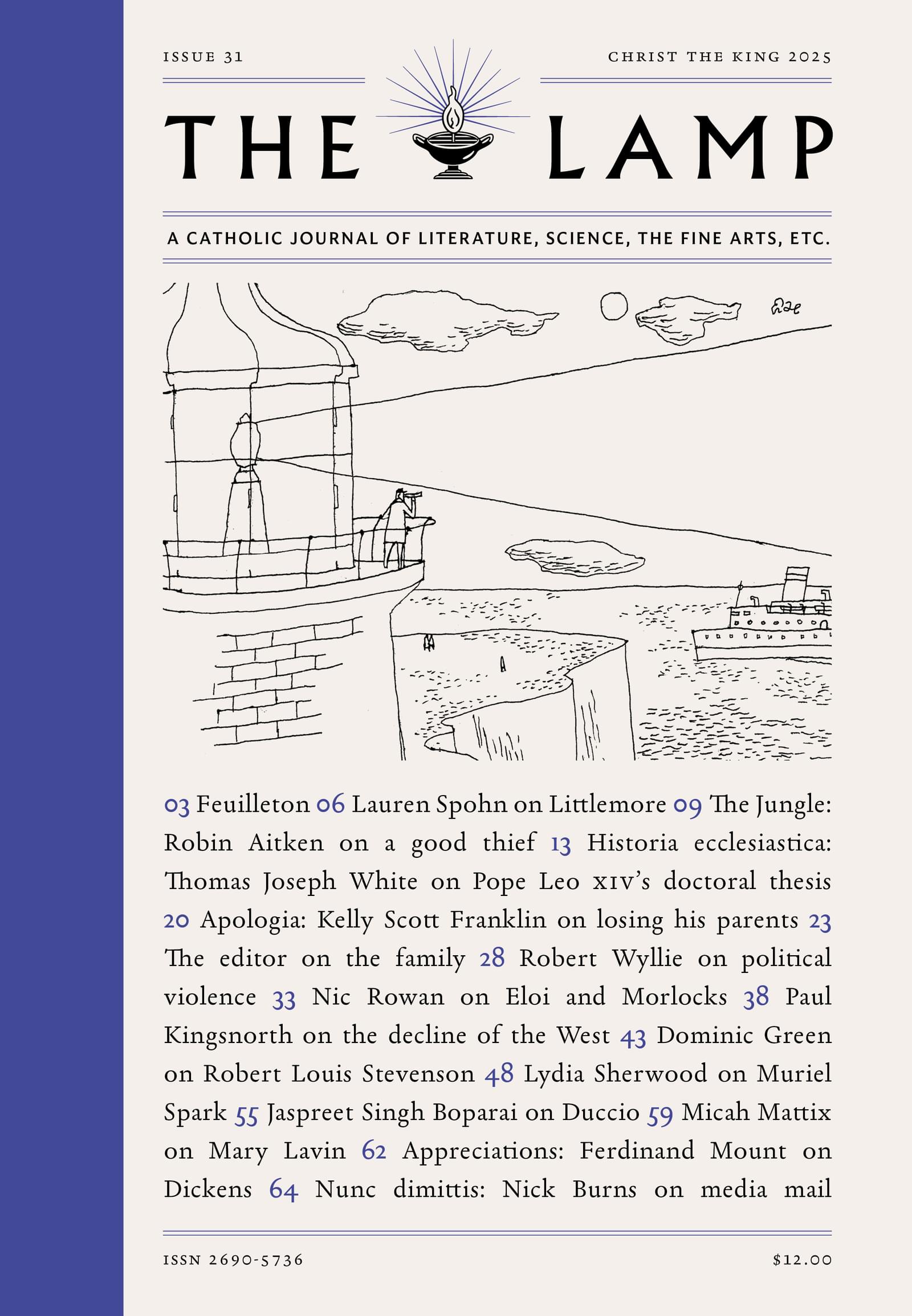Alexander Larman is literary editor of the Spectator World and the author, most recently, of Power and Glory: The Era of Elizabeth II and the Rebirth of Royalty.
Arts and Letters
Woe Others Must End
Friends in Youth: Choosing Sides in the English Civil War, Minoo Dinshaw, Allen Lane, pp. 544, £30.00
Woe Others Must End
When Minoo Dinshaw published his first book, Outlandish Knight: The Byzantine Life of Steven Runciman, in 2016, it was hailed as a highly impressive and distinctive debut. Dinshaw approached his subject, Sir Steven Runciman, not as a dry-as-dust academic but as a Zelig-like figure with a vitally important symbiotic relationship to the scholarship, and inhabitants, of the twentieth century. That this tremendously erudite book was written when its author was in his twenties makes the achievement all the more impressive, although there were some grumblings that youthful enthusiasm had led to an excess of both detail and length. Friends in Youth: Choosing Sides in the English Civil War, Dinshaw’s eagerly awaited sophomore publication, is another scrupulously researched and insightful book that suggests its near-decade-long gestation was time well spent and again exhibits the considerable strengths—and the very few flaws—of Outlandish Knight.
There has been a recent flurry of serious and worthwhile British scholarship about the Civil War and its after-effects. Ronald Hutton has written two excellent books about that most enigmatic of figures, Oliver Cromwell, in The Making of Oliver Cromwell and Oliver Cromwell: Commander in Chief. Both Paul Lay and Anna Keay have written exceptionally well about the thirteen-year period between 1647 and 1660 when Britain was without a king. Clare Jackson’s Devil-Land, meanwhile, deservedly won the Wolfson Prize for its penetrating and authoritative examination of seventeenth-century Britain. I have waited so far in vain for the definitive Charles II biography—nothing of any real note has appeared about the so-called “Merry Monarch” since Jenny Uglow’s Gambling Man in 2009—but doubtless some bright spark is writing a damning obloquy right at this very moment.
Rather less, however, has been written about the prelude to war, and especially the complex political and psychological allegiances of those who took no particular side, not out of moral conviction or personal advancement but because there seemed to be no other viable option. Dinshaw’s vaulting ambition here is to sidestep the usual narratives of kings and Lord Protectors and focus instead on two figures of the sort that tends to be pushed to the margins of more conventional histories: the royalist Edward “Ned” Hyde and the Parliamentarian and “immaculate moderate” Bulstrode Whitelocke.
At its heart, this is a story about friends who agree about far more than not but are divided politically and socially through a mixture of ill fortune and circumstance. Hyde was a royalist, and therefore a Cavalier, whereas Whitelocke was a Parliamentarian, although very far from a Puritan. Both were initially concerned about Charles I’s power-grabbing early in his reign, although neither was anti-monarchist. It was the Grand Remonstrance of 1641, in which Parliament presented a list of grievances to the king, that decided their loyalties; Whitelocke believed that they were justified, whereas Hyde was horrified at their impunity and the casual fashion in which they were passed through the Commons. He later exclaimed, “So near was the poor kingdom at that time to its deliverance!” The eventual, unhappy result would be war.
This is not a straightforward or simple saga. As Dinshaw writes in a valuable second introduction that fills in some of the post-Jacobean intrigue and sets up the early years of the first Carolean age, “This is the story of how two close friends, themselves divided by few if any serious differences of political opinion, united both by generous measures of idealistic vision for their country’s better governance and reasonable ambition for their own personal distinction, inadvertently contributed to their country’s division, and gave their all, in vain, to calm the ensuing turmoil.”
If the (somewhat convoluted) language here is reminiscent of the “arguments” at the beginning of each book of Milton’s Paradise Lost, itself a work strongly imbued with echoes of the Civil War, this can only be intentional: Friends in Youth is a book studded with teasing allusion, whether it is the comparison of the soon-to-be-murdered Duke of Buckingham to the equally doomed Julius Caesar (via Shakespeare, naturally) or the way in which Whitelocke’s oft-mentioned “riding impairment” from his youth comes to take on the same tragicomic resonance as Uncle Toby’s “dismally crushed” pelvic bone. (Whitelocke also gets a musket ball full in the face early in the war, spoiling his looks.) It is no coincidence that Dinshaw takes his title, and epigraph, from Coleridge’s Christabel. His choice of poem reflects his central thesis on two levels: first, its narrative, which revolves around the complex, shifting relationship between the protagonist Christabel and her charismatic, dangerous friend Geraldine, and second, the circumstances of its creation. Coleridge’s decision to omit the poem from Lyrical Ballads came at the instigation of his friend Wordsworth, which may have been either a piece of poetic wisdom or envy of his friend’s accomplishment. It is through this prism that Dinshaw invites us to consider the friendship between Hyde and Whitelocke: Which one is Christabel and which Geraldine—or which Coleridge and which Wordsworth—remains pleasingly ambiguous throughout.
In any case, the depth and sincerity of the relationship between the two men are beyond question. In 1641, the two men were “steadfast companions, who had already stood by one another in law and love, in sociable, aesthetic, marital, and political concerns.” (Dinshaw loves lists; he could usefully have trimmed some of them.) Hyde, the better known of the two, would go on to become the Earl of Clarendon, the most influential and powerful man in Restoration England until his downfall courtesy of his legion of jealous enemies; he was the author of History of the Rebellion, a massive work begun in 1646, three years before Charles’s execution, and published only in 1702, after his death.
Here we see an origin story of sorts for him. The two men were not obvious boon companions when they met at Middle Temple in the mid-1620s. Whitelocke, the older of the two by four years, was a swaggering, self-assured figure who had been groomed for greatness from an early age and was making his precocious first appearance in the House of Commons in 1626, at the age of twenty-one. Hyde was, in Dinshaw’s evocative description, “seemingly fitted by both temperament and destiny for a surviving second son’s quiet, clerical lot.” Both followed in the footsteps of charismatic, able fathers and came of age in the early years of Charles I’s reign.
Friends in Youth is divided into two distinct but complementary sections. The first part chronicles the early years of their friendship, amidst simmering national uncertainty, and allows for walk-on parts for everyone from the playwright and poet Ben Jonson to the hilariously tedious Sir Simonds D’Ewes, “one of the most industrious members and prolix speakers in the House.” The second and inevitably darker part of the book focuses on the turmoil that was caused by the First English Civil War, which divided families and political loyalties alike. Although Whitelocke and Hyde shared similar views, it was a testament to the war’s cruelly alienating nature that they fought on opposite sides.
Dinshaw ends his story in 1646 with the conclusion of the first phase of war and the victory of the Parliamentarian side, but there is a sincere emotional wrench to the evocation of the two men’s valiant but doomed efforts to find a mutually satisfactory peace for their country. The penultimate chapter, “Our Utmost Endeavours,” describes in detail how they were reunited in desperate circumstances at the beginning of 1645, with both men using their legal and oratorical prowess to bring about the ill-fated Treaty of Uxbridge.
The treaty, as Whitelocke wrote ruefully, “caused much trouble in the minds of many honest men, lovers of their country’s peace; and divers of the King’s commissioners, as well as the other, seemed sorry that all their endeavours to so good an end should prove so fruitless . . . most sober men lamented the sudden breach of the treaty.” Dinshaw correctly regards the abortive attempts to bring about a truce as a tragedy of Shakespearean magnitude. His epigraph for the final chapter, “England Commits,” is taken from Romeo and Juliet, with Romeo sourly lamenting his friend Mercutio’s death: “This day’s black fate on more days doth depend; / This but begins the woe others must end.”
Friends in Youth is clearly influenced by the ructions that Britain has undergone during the past nine years, in particular the Brexit vote that divided the country in a similar, though blessedly less bloody, fashion in 2016. Dinshaw refers to it in the acknowledgments, in which he talks of this “fascinating [yet] consistently deranging period.” He goes on to praise his friend the politician and author Rory Stewart (“the most clarifying and most historically conscientious presence in that whole Kalevala of a national conversation”) not only as an admirer of Clarendon but, implicitly, as sharing some of that man’s qualities; Stewart was one of the few Conservatives who went against conventional thinking on Brexit, and his reward was to be expelled from the party. Dinshaw does not labor over the contemporary parallels—a lesser writer would—but they are undeniably lurking, glinting ingots for the committed treasure-seeker.
There is plenty of gold in Friends in Youth, but there is some base metal, too. There are economical, evocative pen portraits, which show Dinshaw’s incisive talent for observation at its best, as well as some bewildering verbiage. The churchman William Chillingworth is “a bookish equestrian,” “a small man of intoxicatingly rapid speech,” and “a man more likely to be called upon for intellectual than practical assistance.” Dinshaw brings us Chillingworth fully formed, and we see him. A murdered lord has a “faintly sodomitical reputation,” and Whitelocke is praised as “an excellently connected lawyer celebrated for wit, dash, industry and courtesy.” All superb, all worthwhile.
When it goes too far, however, it misses spectacularly. I remain unconvinced that Charles I really could be described as “a fragile stalactite of flawless taste.” Dinshaw is a writer who is in love with his own, undeniably considerable, cleverness. But self-conscious cleverness is a dangerous quality in any historian, and I cannot help thinking that this book could have used a ruthless editorial eye. His sentences are frequently florid and expansive, which may or may not be a conscious echo of the ostentation of Charles I’s court, but they can be tricky to parse. And although Hyde in particular emerges as a fascinating character in his own right, there is an inevitable frustration for the reader that his grander arc is only hinted at and foreshadowed rather than told in this volume. Perhaps there will be a follow-up, one hopes rather sooner than in nearly another decade.
Yet for all this, Dinshaw is a talented writer who is as attuned to human frailties and sometimes downright silliness as he is to wider political and social machinations. This is not a book concerned with the minutiae of battle plans or parliamentary strategy, but an examination of human nature—and, in particular, friendship—in impossible, tragic circumstances. As such, it enthralls, enlightens, and, in its sense of waste and regret, cannot fail to move.




